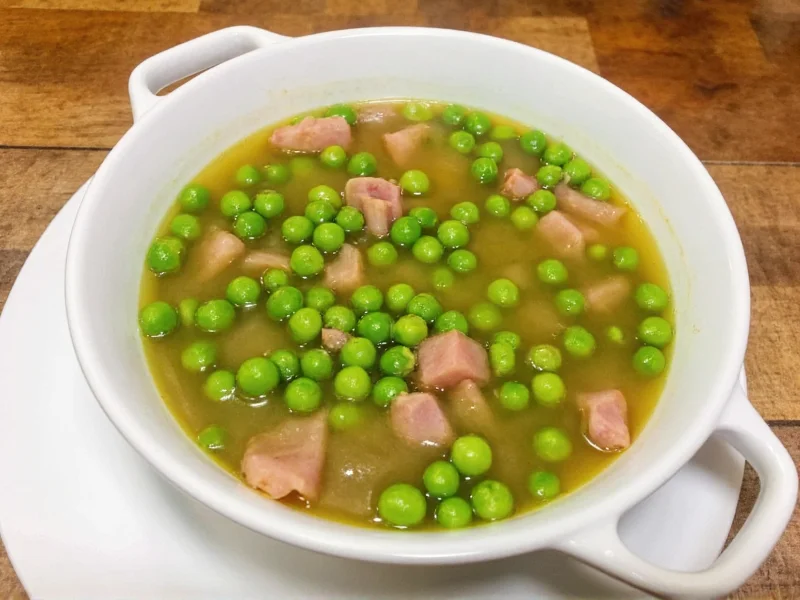For generations, ham pea soup has been a staple in kitchens worldwide, particularly valued for its ability to transform simple, affordable ingredients into a nourishing meal. This humble dish traces its origins to European culinary traditions, where dried peas were a practical way to preserve harvests through winter months. American settlers adapted these recipes using available ingredients, incorporating smoked ham for depth of flavor that defines the dish today.
The Essential Ingredients for Authentic Ham Pea Soup
Creating the best ham pea soup starts with understanding each component's role. Dried green or yellow split peas form the soup's foundation—they're not just economical but packed with protein and fiber. Unlike fresh peas, split peas break down during cooking, naturally thickening the soup without requiring flour or cream.
When selecting ham for pea soup, many home cooks wonder what type of ham works best. A smoked ham hock or ham bone with remaining meat delivers maximum flavor. The collagen in these cuts breaks down during simmering, creating that signature rich texture. For an easy ham pea soup recipe without specialty ingredients, diced smoked ham works well too.
| Ingredient | Quantity | Why It Matters |
|---|---|---|
| Dried split peas | 2 cups | Provides protein, fiber, and natural thickening |
| Ham bone with meat | 1 (about 1-2 lbs) | Creates deep, smoky flavor base |
| Onion, carrot, celery | 1 cup each, diced | "Holy trinity" for aromatic foundation |
| Garlic | 3 cloves | Enhances overall flavor complexity |
| Bay leaves | 2 | Adds subtle herbal notes |
Step-by-Step Homemade Split Pea Soup with Ham
Follow these professional techniques for foolproof ham pea soup every time. First, rinse 2 cups of dried split peas under cold water to remove any dust or debris. While many traditional split pea soup ingredients don't require soaking, rinsing ensures a cleaner final product.
In a large pot, combine the split peas, ham bone, chopped vegetables, garlic, bay leaves, and 8 cups of water or broth. Bring to a boil, then reduce heat to maintain a gentle simmer. Skim off any foam that rises to the surface during the first 15 minutes—this step creates a clearer, cleaner-tasting soup.
Cover and simmer for 1-1.5 hours, stirring occasionally, until peas are completely broken down and soup has thickened. Remove the ham bone, shred any remaining meat, and return it to the pot. Season with salt and pepper to taste—remember that ham contributes significant saltiness, so taste before adding additional salt.
Perfecting Your Pea Soup Texture and Flavor
Many home cooks struggle with how to thicken pea soup properly or achieve that ideal creamy consistency. The secret lies in cooking time and technique. Split peas naturally release starches as they cook, but if your soup remains too thin, remove 1-2 cups of soup, blend until smooth, and return to the pot.
For those seeking creamy pea soup without cream, consider adding a peeled and diced potato during cooking—the potato breaks down and contributes natural thickness. Alternatively, some traditional recipes include a small amount of baking soda (1/8 teaspoon) to help peas break down faster, though this can affect nutrient content.
Variations and Leftover Ham Pea Soup Ideas
One of the beauties of this versatile dish is its adaptability. For a quick weeknight meal, try this slow cooker ham pea soup variation: combine all ingredients in your crockpot and cook on low for 6-8 hours.
Leftover ham pea soup often tastes even better the next day as flavors continue to meld. Transform extra soup into creative meals:
- Ham pea soup grilled cheese sandwiches (spread thick soup on bread before grilling)
- Pea soup stuffed baked potatoes
- Freeze portions for quick future meals (see storage tips below)
Vegetarians can create a satisfying vegetarian alternative to ham pea soup by substituting smoked paprika and liquid smoke for the ham flavor, plus adding mushrooms for umami depth.
Storage and Reheating Guidelines
Proper freezing ham pea soup technique ensures quality preservation. Cool soup completely before transferring to airtight containers, leaving 1-inch headspace for expansion. Frozen soup maintains best quality for 2-3 months.
When reheating, add a splash of water or broth as the soup thickens significantly when chilled. Gently warm over medium-low heat, stirring occasionally to prevent sticking. Never boil reheated pea soup vigorously, as this can cause the peas to become grainy.
Nutritional Benefits of Traditional Pea Soup
Ham pea soup delivers impressive nutritional value beyond its comforting flavor. A single serving typically provides:
- Approximately 250-300 calories
- 15-18g protein from both peas and ham
- 15-20g dietary fiber (more than half the daily recommended intake)
- Significant amounts of iron, potassium, and B vitamins
The combination of plant-based protein from peas and animal protein from ham creates a complete amino acid profile, making this a nutritionally balanced meal. The high fiber content promotes digestive health and provides sustained energy release.











 浙公网安备
33010002000092号
浙公网安备
33010002000092号 浙B2-20120091-4
浙B2-20120091-4